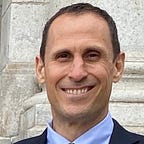Pop-Up Newsroom at Collaborative Journalism Summit demonstrates the value of collaboration
Start with yes. That was the advice Cole Goins gave the audience at the Collaborative Journalism Summit during his panel on partnerships at Montclair State University on May 4. Goins is the director of community engagement at The Center for Investigative Reporting, where they know a few things about using collaboration to produce innovative journalism.
But I almost missed Goins’ message — because I almost didn’t go to the two-day conference in New Jersey.
I almost said no.
Here’s what I learned by saying yes.
I run a startup called Evrybit. It’s a mobile reporting app that streamlines collaborative storytelling. Think of Evrybit as a way to organize reporting and storytelling into one stream using text, photo, video and audio content. Like many early-stage apps, we want more users. One way startups can acquire more users is to increase product awareness with their target audience. For us, that’s journalists. A conference on collaborative journalism sounded like a target-rich environment.
So in December, I contacted one of the Collaborative Journalism Summit organizers I know, Joe Amditis, the associate director of the Center for Cooperative Media at Montclair State University, and shared an idea: Would the center be interested in having me build a pop-up newsroom with Montclair State students to document the summit?
I had led mobile news teams of college students to cover events with Evrybit before (see here, here and here) and thought this would be a win-win collaboration.
Joe liked the idea and suggested I pitch it to Stefanie Murray, the director of the Center for Cooperative Media. She also liked the idea, and we worked out an arrangement for me to lead a mobile news team of Montclair State students at the Collaborative Journalism Summit, with Evrybit serving as a technology sponsor of the conference.
In March, I realized I might not be able lead the newsroom in person. In addition to running a startup, I am the full-time managing editor of Truthdig, a political website. On top of that, my wife runs her own startup (an educational video game company called 7 Generation Games), we have three kids under 9, a dog, and live in Santa Monica, Calif., over 3,000 miles away from Montclair, N.J. At this point in our lives, we don’t have a lot of free time.
“Could I run the newsroom remotely?” I asked Stefanie in an email. She didn’t think that would work. The conference was happening during finals week for students, and she envisioned me leading the pop-up newsroom on site.
I reconsidered my options. After some reflection and schedule rearranging, I decided I would go. I let Stefanie and Joe know. I booked my flight and hotel.
On May 3, I flew to Newark and arrived at my hotel around 10 p.m. I prepped everything for the newsroom and fell asleep around 4 a.m. I woke up a few hours later, got ready and arrived on the Montclair State campus at 7:30 a.m. I met the students and Jaime Bedrin, the faculty mentor for the newsroom, and said hello to Joe and Stefanie. After a pep talk from Joe, I gave the students their assignments, and they went to work.
From 8 a.m. to 5:30 p.m., eight students reported on the summit — taking pictures, recording videos, interviewing attendees, writing text — in one collaborative story. This is the story they produced on Day 1.
They also created individual Evrybit stories on student reporting, graphic facilitation (a new form of notetaking), collaborative storytelling, collaborative reporting and Free Press (an independent advocacy group fighting for media and technology rights).
More students joined our mobile news team on Day 2 to close out the conference. Everyone finished strong.
In all, 13 students participated in the pop-up newsroom at the Collaborative Journalism Summit. I am proud of the work all of them did. They are the future of journalism, and they showed what is possible with a pop-up newsroom and mobile collaborative reporting and storytelling. This collaborative journalism model can be replicated with other students, journalists, media organizations and communities — anyone with a story to tell.
If I had not gone to the Collaborative Journalism Summit, I would have missed the opportunity to work with these students in person and show collaborative mobile journalism in action. Leading the newsroom remotely would not have been the same experience for the students or me.
But that’s not the only opportunity I would have missed. I also would have missed seeing old (and new) friends from my days in the Knight Journalism Fellowships program at Stanford (where Evrybit was hatched), the ONA Boston chapter (which I helped co-found) and the LION Summit (where I met Joe Amditis). At the same time, I would have missed out on meeting new potential collaborators for future projects.
I have been to dozens of journalism conferences over my 17-plus years in digital media, and the Collaborative Journalism Summit was one of the most informative, productive and inspiring conferences I have ever attended.
And to think, I almost didn’t go.
Saying no to collaboration is a common problem in journalism today. We don’t have enough time or resources. We can do it better ourselves. The community won’t meet our standards. The list of reasons for being unwilling to collaborate is long and shortsighted. Instead of thinking why a collaborative project won’t work, journalists and journalism decision-makers should consider how collaboration could benefit them and their newsrooms.
So next time someone approaches you or your media organization with an idea for collaboration — no matter how crazy or challenging the project might seem — resist the urge to say no.
Say yes, and don’t look back.
